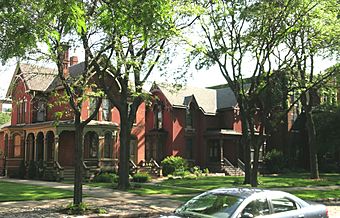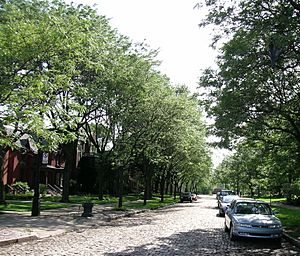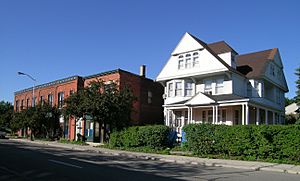West Canfield Historic District facts for kids
|
West Canfield Historic District
|
|

Houses on West Canfield
|
|
| Location | Detroit, Michigan, U.S. |
|---|---|
| Built | 1871 |
| Architectural style | Queen Anne |
| MPS | Cass Farm MPS (boundary increase only) |
| NRHP reference No. | 71000433 (original) 97001092 (increase) |
Quick facts for kids Significant dates |
|
| Added to NRHP | May 27, 1971 |
| Boundary increase | September 22, 1997 |
The West Canfield Historic District is a special neighborhood in Detroit, Michigan. It is mostly found on Canfield Avenue, between Second and Third Streets. This area is known for its beautiful old homes. Later, the district grew to include buildings on Third Avenue.
This historic district was recognized as a Michigan State Historic Site in 1970. It was then added to the National Register of Historic Places in 1971. The district was made larger in 1997. This lively neighborhood from the 1870s is near Detroit's Cultural Center. Close by, you can find the Detroit Medical Center. You can also see the St. Josaphat's Catholic Church and the Sweetest Heart of Mary Catholic Church.
History of West Canfield
The land where the West Canfield Historic District now stands once belonged to Lewis Cass. He was an early governor of Michigan. When he passed away in 1866, his two daughters inherited his property.
Three years later, in 1869, his daughters divided the land. Mary, one of Cass's daughters, received the part where the historic district is today. Mary's husband was Captain August Canfield. He was a graduate of West Point. He also invested a lot in building the ship canal at Sault Ste. Marie.
In 1871, Mary Cass Canfield divided her land into smaller plots. She named Canfield Avenue after her husband, Captain August Canfield.
The street quickly became home to many successful people. These included lawyers, doctors, dentists, and architects. Building continued through the 1880s. West Canfield remained a top place to live in Detroit for many years.
In the 1930s, the Great Depression caused the neighborhood to decline. But in the 1960s, the area was brought back to life. The historic look of the street was restored. New residents have continued to care for and improve this lively Midtown neighborhood. This work continues into the 21st century.
Architecture and Design
In the early 1870s, many brick homes were built along Canfield Avenue. These homes were in the Queen Anne style. They were placed on large lots with plenty of space in front.
The original plan for the area was very specific. Each lot was 50 feet wide and 190 feet deep. There was also a rule for a 30-foot space in front of each house. This space was for sidewalks, plants, and decorations.
In the early 1980s, the street was made narrower. It was returned to its original 1870s design. Granite pavers were added to the street. New street lamps, like the old ones, were put in place. Trees were planted, and grassy areas were added in the middle of the street.
In 1970, the West Canfield District received special historical recognition. It was the first district in Detroit to be recognized by both the state and the city. The district was then placed on the National Register of Historic Places the next year. In 1997, the district was made larger. It now includes three more buildings on Third Street. These include another Queen Anne style house and two Victorian commercial buildings. This vibrant neighborhood has seen many updates and improvements in recent years.
See also
 In Spanish: Distrito Histórico de West Canfield para niños
In Spanish: Distrito Histórico de West Canfield para niños



